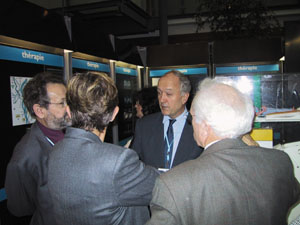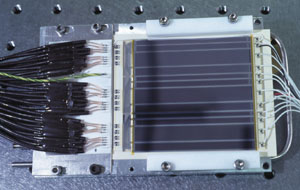When new experiments require new instrumentation, the resulting R&D can also provide spin-off
developments with wider uses. A major shop window for these is the annual Nuclear Science Symposium and
parallel Medical Imaging Conference. Chris Damerell and Chris Parkman report on the latest event in the series.

An expert, runs the saying, is one who knows more and more about less and less. An annual mecca for
instrumentation experts is the Institute of Electronic and Electrical Engineers (IEEE) Nuclear and Plasma Physics
Society’s combined annual Nuclear Science Symposium (NSS) and Medical Imaging Conference (MIC). In 2000,
this major event visited Europe for the first time in its more than 45-year history, and a major theme was to
amplify expert knowledge by refocusing specialists’ attention onto important developments across a wider
front.
Although they share many technologies, the NSS and MIC have traditionally been separate but
concurrent events. In recent years a number of combined sessions have been held, but the 2000 event set out to
bring the two communities together, with instrumentation-related contributions classified according to their
fundamental technologies rather than their areas of application.
Topics covered included radiation detection
and new detector materials; electronics and image reconstruction algorithms; complex radiation detector systems
for physical science; and advanced imaging systems for applications in biological and medical research.

Held
on 15-20 October at the Palais de Congrès in Lyon, France, under the general chairmanship of Patrick Le Dû of
CEA Saclay, the event was sponsored by all of the leading European laboratories, including the CEA and CERN,
as well as the local and regional governments.
The scientific programme, chaired by Chris Damerell of the
Rutherford Appleton Laboratory in the UK for the NSS and Stig Larsson of the Karolinska Hospital in Stockholm
for the MIC, made a major effort to boost communication between the two traditional communities. It attracted
more than 750 papers, from which the Programme Committee, under Jean-Pierre Dufey of CERN, was able to put
together a compelling agenda.
The overview talks covered a range of subjects: the impact of deep
submicron electronics on science and society; micropattern gas detectors (with wide-ranging imaging capability);
the use of positron emission tomography (PET) in psychiatry; open source software; GRID computing; and the
positive and negative impact of ionizing radiation on health.
Despite the eagerness to hear about the latest
developments in semiconductor detectors, the more traditional scintillation and gaseous detectors still pull in the
crowds. Scintillation detectors provided early real-time particle sensors in the form of zinc sulphide screens.
Throughout their long history, they have led the field for X- and gamma-ray detection.
The largest individual
systems are obviously those used in the giant collider experiments for particle physics, but medical imaging
provides a huge market for more than 100 tonnes of scintillator each year. The technology is evolving rapidly, as is
the closely related topic of photodetectors.
Gaseous detectors started out as bulky devices (Geiger and
proportional counters) with crude spatial information. The evolution through drift chambers and multiwire
proportional chambers provided precise one-dimensional information and a host of application
areas.
Exciting prospects
One might have imagined that, having achieved 100 µm resolution, the pace
of development would be slowing down. Not at all – micropattern detectors represent a new field with a host of
exciting prospects for true two-dimensional imaging applications.
Since the invention of the planar process
leading to silicon integrated circuits, the effect of semiconductor devices on detector technology has been equally
dramatic. Silicon microstrip detectors have evolved in a bewildering variety of directions. They offer extremely fast
tracking and can be assembled into large structures, such as the 235 m2 area planned for the CMS
experiment at CERN’s LHC collider.

On a smaller scale, pixel-based silicon devices offer very high spatial
precision as vertex detectors. Increasingly, such devices are being used in scientific imaging, as well as in more
everyday equipment, such as the camcorder. For the scientific market, charge-coupled devices, hybrid and
monolithic active pixel devices are being developed, each with its own preferred areas of application. One of the
high points of the parallel sessions was a talk on imaging with silicon detectors, during which a packed auditorium
heard new results on applications in medicine, crystallography and high-energy physics.
In addition to the
exciting progress in silicon detectors, there have been remarkable developments with other semiconductors. These
included presentations on CdZnTe/CdTe-based technology, not only exploring the device physics in great depth
but also detailing its real-life applications.
For other materials, too (Ge, diamond, GaAs and InP), progress
has been equally spectacular. In many cases, the superb energy resolution of these devices is maintained while
moving towards the spatial precision associated with silicon.
New applications of liquid xenon technology
covered both gamma-ray directional reconstruction in the difficult mega-electronvolt range, and the search for
weakly interacting massive particles.
Underpinning many of these developments is the continuing rapid
progress in electronics and computing. Front-end electronics was the most popular of all of the parallel session
topics, with eight oral sessions (every morning and afternoon) and five poster sessions.
New ideas in
radiation-tolerant circuit design, signal processing and low-noise circuits were presented. The session on circuits
for medical applications provided an interesting example of advanced electronics techniques applied to PET
instrumentation, building more bridges between nuclear techniques and medical instrumentation.
The
discussion of Novel Technologies covered very special devices, such as thermometers for cryogenic detectors,
hydrophones for detecting high-energy reactions in water and imaging plates for the detection of heavy particles. It
culminated in an overview of new methods and detectors for high-efficiency, high-resolution X- and gamma-ray
imaging.
In the imaging domain, several new ideas are being studied, such as a multi-Compton scattering
technique based on back-scattered photons, and a method for reconstructing gamma-ray trajectories using
information from segmented high-purity germanium detectors.

A new detector material made of
polycrystalline films of mercuric iodide, to be coupled to thin amorphous silicon transistor arrays, is being
prototyped. A number of operational devices for X- and gamma ray detectors were also presented.
The
pedagogical mission of the NSS-MIC was strongly in evidence: in addition to the traditional short courses
(organized this year by Fabio Sauli of CERN), an innovative series of three one-day workshops was held. More
than 300 students, ranging from postdoctorate to senior level, benefited from seven courses on topics that included
solid-state detectors in particle physics; particle identification and detectors for X- and gamma-ray astrophysics;
analytical reconstruction; X- and gamma-ray imaging; PET; and discrete reconstruction methods.
The
workshop on Advances in Electronic Portal Imaging was arranged on behalf of the European Federation of
Organizations for Medical Physics by Alberto Del Guerra and designed to act as a bridge between the radiation
detector community and radiotherapy professionals.
It began with a review of the Electronic Portal Imaging
2000 conference (held a few months earlier), which covered the most advanced digital detectors for portal
imaging, and was followed by presentations on Monte Carlo simulation and dosimetry measurements. Finally, the
image quality and image analysis of digital portal imaging was discussed from both a physical and a clinical point
of view.
The Basic Science and Entrepreneurship workshop was organized by François Bourgeois of
CERN, Alan Jeavons of Oxford Positron Systems (UK), Yves Jongen of Ion Beam Applications (Belgium) and
Gert Muehllehner of ADAC-UGM (US) (see March 2001
News).
Following successful workshops held at Fermilab in 1994 and Osaka, Japan, in 1996, the
workshop on Network-Based Data Acquisition and Event-Building was particularly relevant in view of the
forthcoming need to choose technology for the LHC experiments’ data acquisition systems, due to start work in
2005.
The state-of-the-art exhibition hall at the Palais de Congrès was used to good advantage by the
Industrial Programme, chaired by Chris Parkman of CERN, allowing more than 50 exhibitors to take part. In an
effort to maximize the mutual benefit to industry and the research community, exhibitors participated in a series of
technical seminars, and small companies and new entrepreneurs were able to contribute to the industrial
programme.
The presentations, together with all of the contributed papers, will be available on CD-ROM
shortly. This will give newcomers and experts alike an up-to-date overview of developments in both nuclear
science and medical imaging.
The 2001 NSS-MIC will be held on 4-10 November in San Diego, California.
Full details are available at http://www.nss-mic.org.








